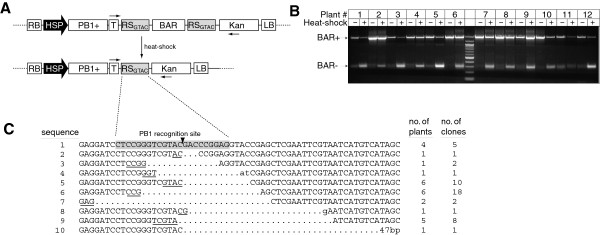Figure 3.
Induction of PB1+ endonuclease removes BAR gene from Arabidopsis plants. (A) Schematic of the JJS30 T-DNA before and after induction of the PB1+ endonuclease. Two RSGTAC sites flank the BAR gene, so that induction of the endonuclease excises the herbicide resistance gene from the genome. The heat-inducible promoter Hsp18.2 controls expression of PB1+. Arrows indicate location of PCR primers used to assay for BAR excision. (B) PCR analysis of JJS30 primary transformants before and after heat-shock, using primers shown in (A). Unmodified JJS30 T-DNA yields a PCR product approximately 1200 bp in length (BAR+), whereas JJS30 lacking the BAR gene is approximately 300 bp (BAR–). (C) DNA sequence of repair junctions from BAR– clones. The approximately 300 bp PCR products from (B) were cloned and sequenced to evaluate the DNA repair junctions. Forty-six clones were evaluated that represented ten plants yielding a significant amount of BAR minus (-) PCR product (excluding plants 2 and 11). Ten unique sequences were obtained and these are aligned with the “perfect re-ligation” product (sequence 1), in which the reconstituted PB1 recognition site is shaded and the location of phosphodiester bond cleavage/re-ligation is indicated by the arrowhead. Total number of independent clones that yielded each sequence is indicated, as well as the number of individual transformed plants that yielded those clones. Bases that are conserved between the two halves of the repair junction (microhomology) are underlined. Single and double base insertions at the repair junction are shown in lower case (sequence 8 and 4, respectively).

